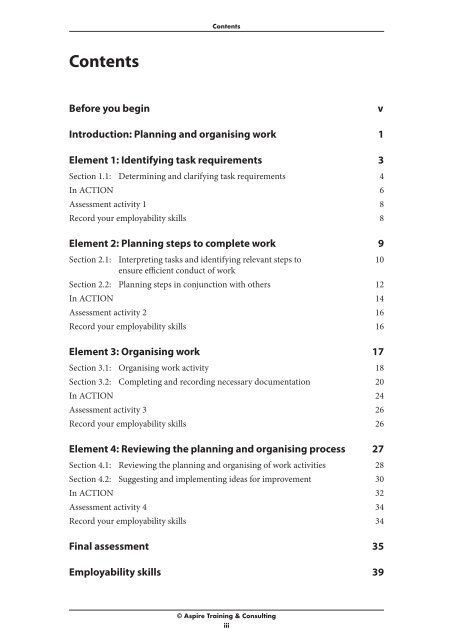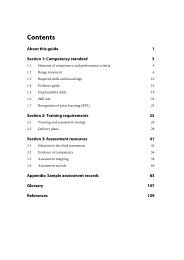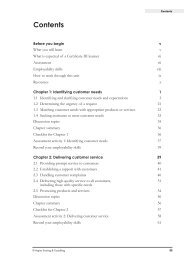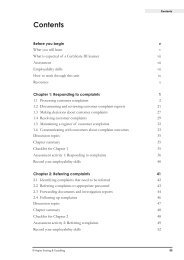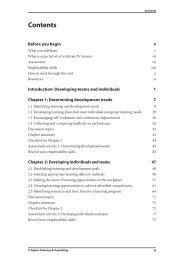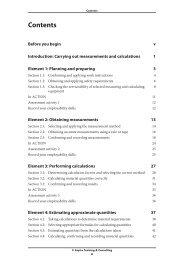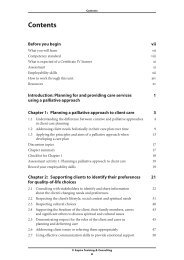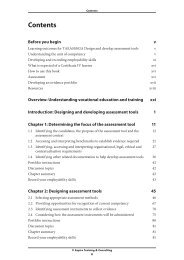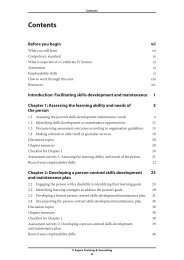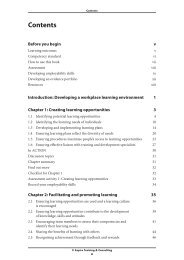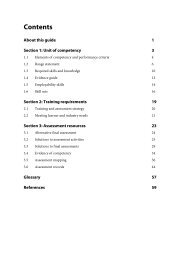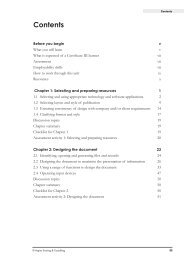CPCCCM1013A Plan and organise work - Aspire Learning Resources
CPCCCM1013A Plan and organise work - Aspire Learning Resources
CPCCCM1013A Plan and organise work - Aspire Learning Resources
Create successful ePaper yourself
Turn your PDF publications into a flip-book with our unique Google optimized e-Paper software.
ContentsContentsBefore you beginvIntroduction: <strong>Plan</strong>ning <strong>and</strong> organising <strong>work</strong> 1Element 1: Identifying task requirements 3Section 1.1: Determining <strong>and</strong> clarifying task requirements 4In ACTION 6Assessment activity 1 8Record your employability skills 8Element 2: <strong>Plan</strong>ning steps to complete <strong>work</strong> 9Section 2.1: Interpreting tasks <strong>and</strong> identifying relevant steps to 10ensure efficient conduct of <strong>work</strong>Section 2.2: <strong>Plan</strong>ning steps in conjunction with others 12In ACTION 14Assessment activity 2 16Record your employability skills 16Element 3: Organising <strong>work</strong> 17Section 3.1: Organising <strong>work</strong> activity 18Section 3.2: Completing <strong>and</strong> recording necessary documentation 20In ACTION 24Assessment activity 3 26Record your employability skills 26Element 4: Reviewing the planning <strong>and</strong> organising process 27Section 4.1: Reviewing the planning <strong>and</strong> organising of <strong>work</strong> activities 28Section 4.2: Suggesting <strong>and</strong> implementing ideas for improvement 30In ACTION 32Assessment activity 4 34Record your employability skills 34Final assessment 35Employability skills 39© <strong>Aspire</strong> Training & Consultingiii
<strong>CPCCCM1013A</strong> <strong>Plan</strong> <strong>and</strong> <strong>organise</strong> <strong>work</strong>Section 1.1:Determining <strong>and</strong> clarifying taskrequirementsA significant factor in the successful completion of any <strong>work</strong> task is accuratelydetermining exactly what it is you are required to do. It is worth clarifying therequirements upfront in order to minimise delays <strong>and</strong> wastage due to errors. You canuse a variety of communication methods to identify exactly what your <strong>work</strong> taskinvolves. Some communication tips include:• Listen carefully to your supervisor at daily planning meetings (or kick-off meetings)to ensure you fully underst<strong>and</strong> what is required of you. You will also be provided withinformation about other sub-contractors’ requirements <strong>and</strong> how <strong>work</strong> arrangementsare scheduled so tasks are completed in a logical <strong>and</strong> efficient manner.• Ask questions to check you underst<strong>and</strong> the requiredtasks or to clarify points you are uncertain of. Your directsupervisor will appreciate you clarifying aspects you areunsure of instead of proceeding <strong>and</strong> wasting time, resources<strong>and</strong> money through making errors. Sometimes it may benecessary to use a two-way radio or phone to speak to yoursupervisor if they are not close by.• Read all instructions, plans, specifications <strong>and</strong> drawings,job sheets <strong>and</strong> other relevant documentation as thisprovides further clarification about the task <strong>and</strong> what youare expected to do.• Use any visual cues. Your supervisor can inform you of any formal visual cues, safetyor warning signs that you need to be aware of, especially where loud equipment maybe operating. Pay particular attention to this information as each <strong>work</strong> place mighthave unique cues that are used on site.• Use technology such as a mobile phone or computer to assist if your supervisor isnot available. Companies may provide fact sheets or information about using theirproducts. Product labels <strong>and</strong> advertising information may provide a phone numberor website address that might be a good source of information. A two-way radio mayalso be useful to request assistance from more experienced colleagues or supervisors.Misinterpreting information in the construction industry can be very costly in terms oftime, money <strong>and</strong> safety. Your attitude <strong>and</strong> communication skills with co-<strong>work</strong>ers, subcontractors,suppliers <strong>and</strong> the client’s representatives are a major factor in the successof your job. Always make sure that you choose the most appropriate communicationmethod for each situation <strong>and</strong> take into consideration cultural, technological, safety<strong>and</strong> environmental factors.Clear communication, good organisation <strong>and</strong> prior preparation will ensure that you doyour job well <strong>and</strong> avoid costly mistakes or injury.Make sure you are familiar with any specifications, plans <strong>and</strong> drawings so that thequality of your <strong>work</strong> is to the required st<strong>and</strong>ard <strong>and</strong> you will be less likely to misinterpretinformation as you <strong>work</strong>. If you know what your task will be ahead of time you canprepare yourself by reading relevant documents or discussing the task with your co<strong>work</strong>ers.Being familiar with task methods <strong>and</strong> required resources before you begin atask will cut down on time spent learning on the job.© <strong>Aspire</strong> Training & Consulting4
Element 1: Identifying task requirementsSafety <strong>and</strong> environmental protection issues are an essential element to any <strong>work</strong> carriedout on a construction site. Make sure you are familiar with safety <strong>and</strong> environmentalrequirements prior to undertaking any task <strong>and</strong> plan your task stages with this in mind.Find out moreBuy Two Way RadiosResourceTwo way radios for constructionwww.buytwowayradios.com/cat/2-wayradios/guide/business/use/construction.aspxMiTek Australia LtdHome of gang-nail building systemswww.mii.com.auWhy it is usefulThis web page provides information aboutusing two way radios in construction <strong>work</strong>,including detailed specifications for differentbr<strong>and</strong>s <strong>and</strong> models.This website provides information <strong>and</strong> freelydownloadable information about products,<strong>work</strong> methods <strong>and</strong> safety information for theconstruction industry.Section task 1.11. List the five main communication methods that can be used to determine, confirm <strong>and</strong> clarifytask requirements.2. Describe how prior preparation can assist you to accurately interpret specifications <strong>and</strong>requirements of a job task.© <strong>Aspire</strong> Training & Consulting5
<strong>CPCCCM1013A</strong> <strong>Plan</strong> <strong>and</strong> <strong>organise</strong> <strong>work</strong>In ACTIONGraham’s storyWhile <strong>work</strong>ing on the high-rise apartment project, Grahamneeds to ensure arrangements are in place for the deliveryof concrete for the flooring of the first-level apartments.Graham looks over the tasks that have to be completedprior to the arrival of the concrete. He does this to ensure thesafe application of the concrete into the form<strong>work</strong> structure<strong>and</strong> makes a few notes about outst<strong>and</strong>ing tasks <strong>and</strong> thetime frames each require. Graham notices the form<strong>work</strong>team have a lot to do in order to be ready for the concretepouring. He makes a note to discuss this with the teamleader at the pre-start meeting or before if possible.The concrete has been ordered for 1.30 pm that day. This leaves enough time in the afternoon tofinish the concrete surfacing. The concrete will have Sunday to continue to cure <strong>and</strong> strengthen.It is important everything is completed in preparation for the arrival of the concrete, in order for<strong>work</strong> to continue next week, once the concrete is hard enough to walk on.Graham makes a few quick calculations about the allocated time for each task <strong>and</strong> finds heneeds to check the progress of some of these with his co-<strong>work</strong>ers. He speaks with his co-<strong>work</strong>ersprior to the pre-start meeting to ensure they can complete their tasks in the required time.Graham also spends time with the form<strong>work</strong> team to resolve the outst<strong>and</strong>ing <strong>work</strong> issues. Theydecide to add two extra <strong>work</strong>ers to the team to help finish the task in time.Once Graham has allocated the tasks <strong>and</strong> how long they each require, he calls a meeting todiscuss the plan <strong>and</strong> inform everyone about the requirements for the 1.30 pm arrival of theconcrete. At the pre-start meeting Graham’s co-<strong>work</strong>ers have a few questions about which areaof the concreting will be commenced first. They also discuss what activities they can then <strong>work</strong>on while the concrete is being poured.The concrete truck arrives at 1.00 pm <strong>and</strong> Graham meets with the driver to <strong>organise</strong> where theconcrete is to be poured first <strong>and</strong> sequentially after that. Graham gives the concrete deliverydriver instructions about where he can <strong>and</strong> cannot be on the <strong>work</strong> site for safety reasons. Hechecks the invoice for details requested in the order to ensure the concrete meets the specificationsthey require. Graham knows it is important to do this prior to pouring the concrete as it wouldbe a costly mistake to pour the wrong mixture or quantity of concrete. Graham completes therequired documentation <strong>and</strong> places it in the folder in the site office.Once the concrete has been poured Graham makes an entry into the site progress folder. Hemakes specific mention of the project progress made by the form<strong>work</strong> <strong>and</strong> concrete finishingteams. He also makes notes about how long it takes the concrete to set in certain areas <strong>and</strong>when those areas will be safe enough for people to resume <strong>work</strong>ing on them.Revision• Pre-start meetings provide an opportunity to <strong>organise</strong> <strong>work</strong> activities <strong>and</strong> coordinatethese with co-<strong>work</strong>ers <strong>and</strong> other contractors.• The organisation of <strong>work</strong> activities <strong>and</strong> completion of relevant project documentationsaves time, money <strong>and</strong> resources through efficient <strong>work</strong> practices.• Liaising <strong>and</strong> communicating with others to <strong>organise</strong> <strong>work</strong> ensures safer <strong>work</strong>ingarrangements for all. • Project progression depends on the successful completion of tasks in order ofpriority.© <strong>Aspire</strong> Training & Consulting24
Element 3: Organising <strong>work</strong>• Completing the required documentation is an essential form of communication ona construction site.• Each contractor has their own documentation requirements <strong>and</strong> <strong>work</strong>ers areinformed of these at induction.Are you ready?Use this checklist to assess if you are ready for assessment activity 3.I underst<strong>and</strong> how to: Organise <strong>work</strong> activity Complete <strong>and</strong> record necessary documentation© <strong>Aspire</strong> Training & Consulting25
<strong>CPCCCM1013A</strong> <strong>Plan</strong> <strong>and</strong> <strong>organise</strong> <strong>work</strong>Section 4.1:Reviewing the planning <strong>and</strong>organising of <strong>work</strong> activitiesQuality project management requires that time <strong>and</strong> effort is put into reviewing theplanning <strong>and</strong> organising process to see where efficiencies can be improved.The following example shows the cyclical nature of planning, task completion <strong>and</strong>review. Each phase is dependent upon the other <strong>and</strong> with regular review, will result inprocess improvement.ExampleProject planning cycleReview planningto improveprocessProject/taskinitiation <strong>and</strong>planningActivate planningto completeproject/taskOn a construction site the planning <strong>and</strong> organisation of <strong>work</strong> occurs on many levels. Thesite manager plans activities based on what has to happen first. For example, what has tobe completed before the next task can begin. Each day these goals are broken down furtherinto sub-tasks which are discussed at pre-start meetings. Organising teams <strong>and</strong> resources tocomplete tasks is an ongoing process that needs to be flexible to allow for contingencies.Reviewing the process is traditionally undertaken at the completion of the project;however, smaller reviews may be necessary throughout the project as more informationis available. For example, if a supplier cannot get an order of materials to site on timethen the manager has to review the priorities <strong>and</strong> reschedule tasks to accommodate thechanged delivery schedule. The process is reviewed with respect to identifying anothersupplier or allowing more lead time for the order to ensure materials arrive on time.These decisions impact the planning <strong>and</strong> organisation for the next project leading toimprovements such as better time <strong>and</strong> resource management.© <strong>Aspire</strong> Training & Consulting28


